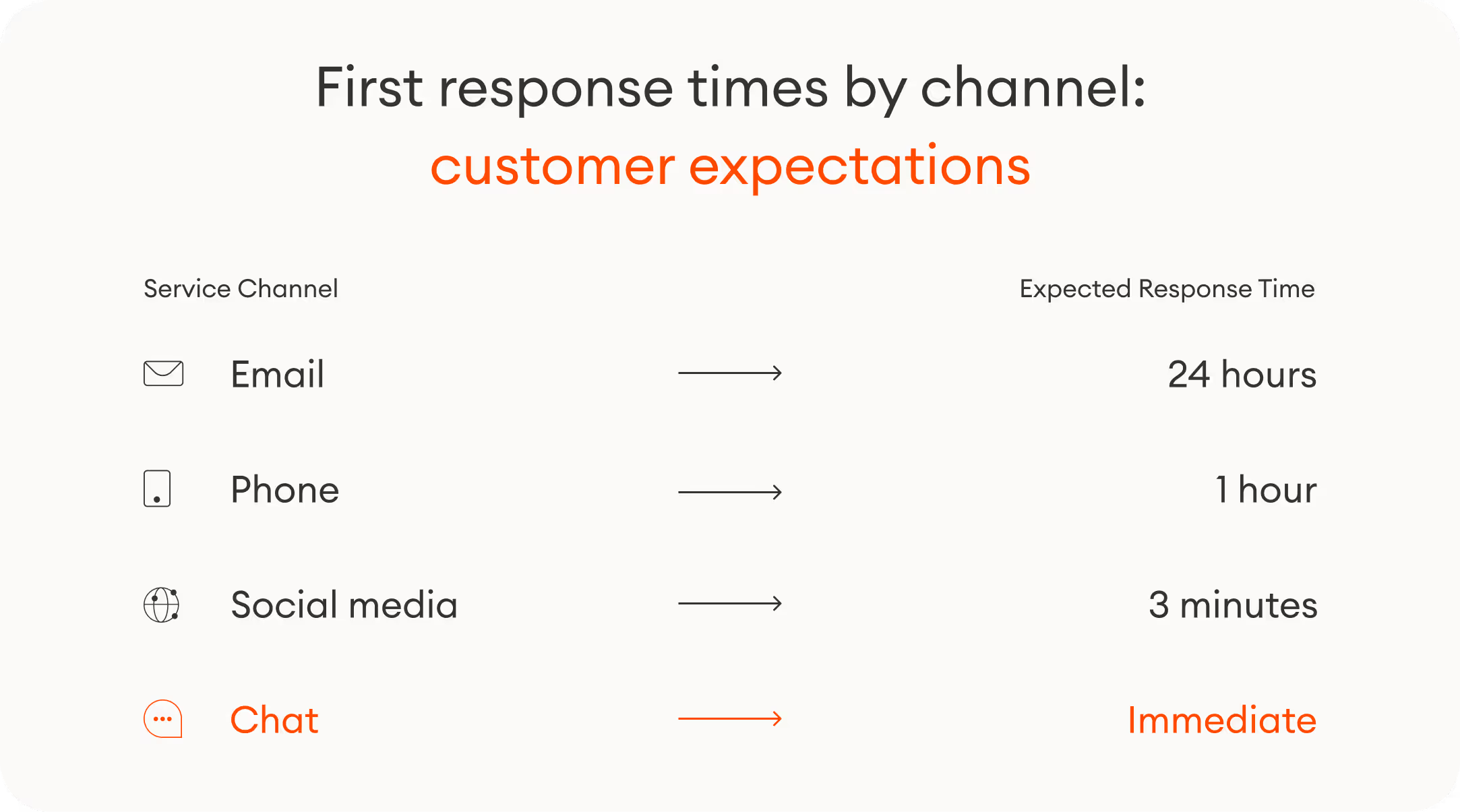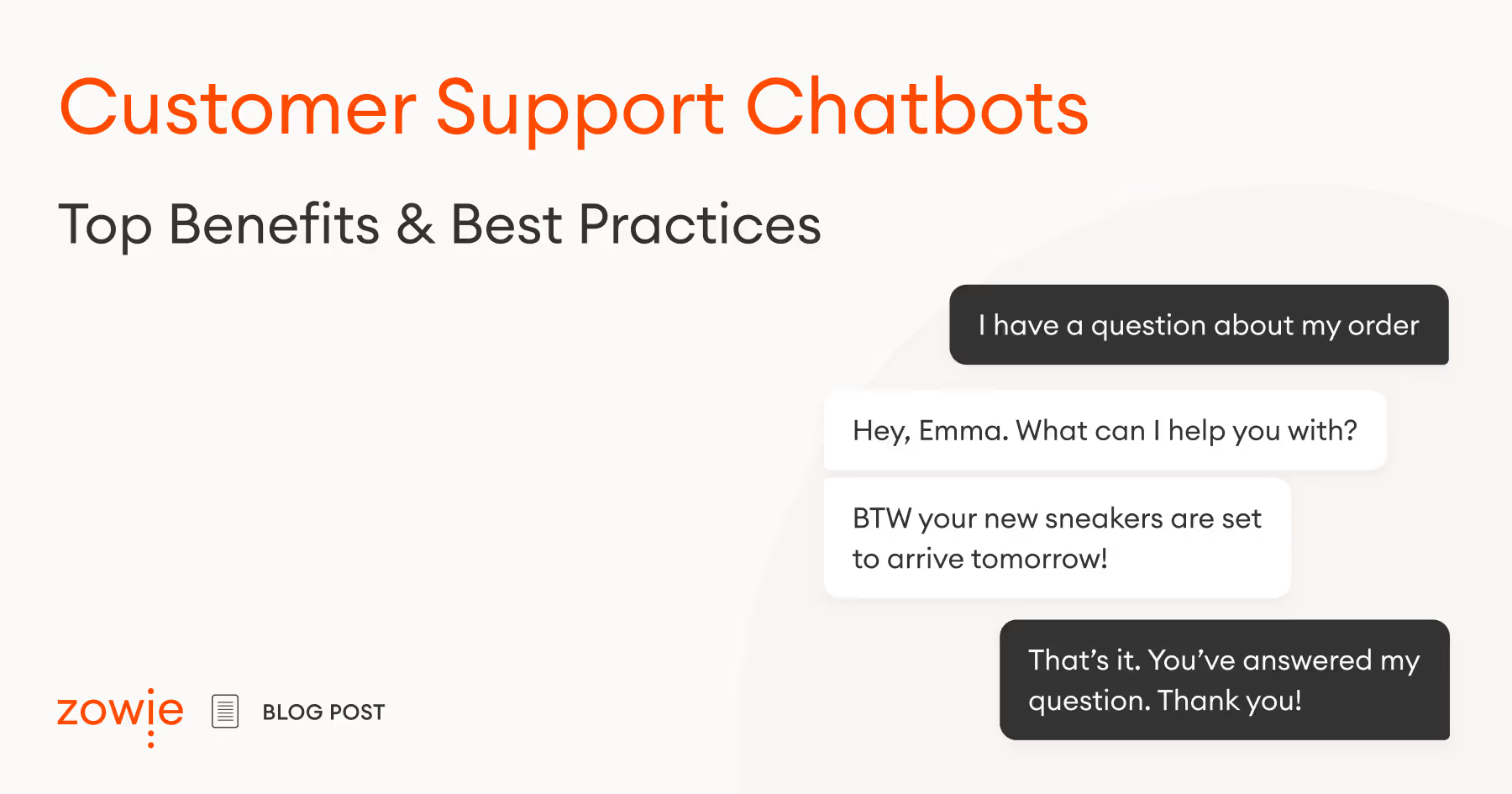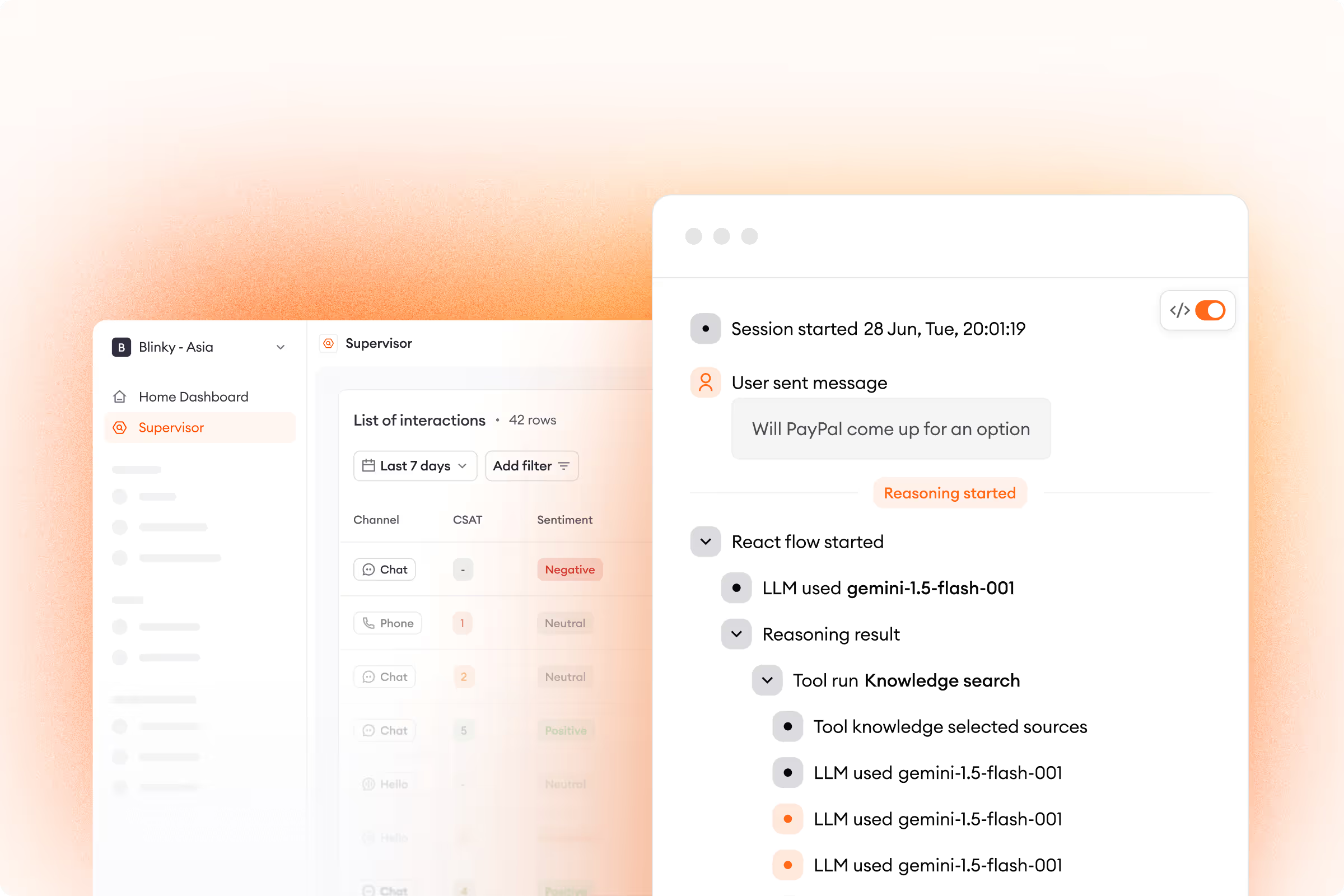When you think of chatbots, do you picture robotic responses, inaccurate info, and endless loops that get you nowhere?
These may have been true of chatbots in the past, but today’s tools have come a long way and are transforming online customer support as we know it.
In ecommerce, chatbots and other AI-powered automation solutions are expected to handle 95% of customer interactions by 2025. And this isn’t just some business fad — 86% of shoppers expect digital storefronts to offer self-service options like a chatbot.
The field’s transition toward chatbots only seems natural. As shoppers demand service that’s fast, convenient, and engaging, more companies are realizing chatbots are the only solution capable of delivering it.
This article explores what customer service chatbots are and the top benefits they bring businesses today.
What are customer support chatbots?
Customer support chatbots are computer programs that mimic human conversations to answer customer questions and offer support without the need for human intervention.
Chatbots can handle various tasks, including answering simple questions (like how much does shipping cost?), updating and modifying orders, and providing product advice.
Chatbots are usually used through a chat widget on ecommerce websites, but they can also interact with shoppers over SMS, social media platforms, and more. They act as a virtual assistant to either help customers self-serve or transfer users to the appropriate agent.
Different chatbots have different capabilities, with the most advanced versions capable of sophisticated tasks like detecting buying intent and recommending products to shoppers based on customer data like location, demographic information, or purchase history.
Why are customer support chatbots important?
For any company trying to expand in ecommerce, a chatbot is increasingly becoming a necessity — not some nice-to-have tool. Capable of automating 70%+ of customer requests, they’re the simplest and most efficient way to scale your customer service without sacrificing quality.
Since customer service chatbots typically pull their answers straight from a business’s knowledge base, they provide instant, accurate help and are more effective than other customer service options for the following reasons:
- They’re much faster than traditional forms of support, like contacting a service rep via telephone, email, or SMS.
- They’re more convenient and efficient than other self-service support options, like hunting down frequently asked questions (FAQs) online. Rather than having to find the answer to their specific query on their own, customers simply ask the bot their question and get an immediate reply.
- They allow for consistently positive customer service experiences. With a chatbot, you never have to worry about each customer having a different experience based on factors like a human agent’s mood or ticket volume.
Types of customer support chatbots
There are 3 main types of customer support chatbot businesses can choose from:
1. Menu-based chatbots
These use a decision-tree flow to give shoppers a predefined list of choices they can click on. When interacting with these basic chatbots, customers can’t type in their own questions, resulting in a limited tool that creates a rigid, underwhelming user experience.
2. Keyword-based chatbots
Users can type their own questions into keyword-based chatbots, but these solutions only give correct answers if customer queries include specific keywords that the bot has been trained on. The conversational flow is slightly better, but keyword chatbots still have a high chance of not understanding a shopper’s request.
DID YOU KNOW? Menu-based and keyword-based chatbots are also known as rule-based chatbots.
3. AI chatbots
Chatbots powered by artificial intelligence (AI) use machine learning algorithms to understand human language and recreate natural conversations. Unlike other chatbots, AI solutions can recognize conversational patterns and interpret user input. This allows top AI chatbots to comprehend a wider range of customer questions and deliver natural, human-like responses.

AI chatbots are the most advanced of the three, and they’re currently redefining what good customer service looks like. Read on to learn the 10 biggest benefits that customer service chatbots are bringing to organizations today.
Top 10 benefits of customer support chatbots
1. Instant interactions that meet customer demands
Customer service chatbots deliver shoppers instant answers — something no other support channel can guarantee with consistency.
Customer expectations are higher than ever, and shoppers want immediate responses to their questions. Email, social media, and telephone can’t deliver those times. But chat can. Enhancing customer support with a chatbot is the only way businesses can consistently answer customer queries within seconds.

And it’s not just about lower response times. Chatbots also help customers leave feedback in real time, letting support teams immediately learn what they’re doing right and what needs improvement. This also allows customers to feel heard since they don’t need to take any additional action or dedicate any more time to sharing their opinions.
2. Greater productivity
Chatbots don’t just enhance the customer experience — the agent experience sees a boost as well. By handling routine tasks, chatbots lower resolution times and free up customer service representatives to focus on more complex issues that require their expertise. With low-value tickets removed, support reps can spend more time addressing more specialized, higher-value cases.
Chatbots save customer service teams over 2 hours of free time per agent each day, making sure support reps keep a manageable workload with minimized burnout. An improved agent experience also reduces customer support turnover, helping out businesses as a whole.
3. Cost savings
Customer service chatbots can rapidly drive support costs down.
How?
Teams are able to handle a higher volume of tickets in a shorter time without needing to hire or train additional human support agents. Chatbots have demonstrated the ability to handle the workload of 8 agents, meaning service leaders can keep a lean structure as their business grows.
This holds true even when ticket traffic spikes. Chatbots don’t get tired or overworked, so businesses equipped with one can instantly support customers during their busiest seasons without needing to invest in seasonal agents.
4. Support-driven revenue
Reducing costs is one thing, but chatbots are powerful tools ecommerce businesses can deploy to turn their support centers into revenue centers as well. Capabilities like proactive chat, customer intent detection, product recommendations, and automated follow-ups help put a company’s products squarely in front of shoppers.
With proactive care, for instance, customer service agents no longer have to wait for customers to place a phone call, send an email, or start a chat. The right chatbot can detect when website visitors are ready to buy and proactively start the conversation.
Leading chatbots are able to guide shoppers through checkout, prevent cart abandonment, and upsell or cross-sell relevant products to send conversion rates and average order value soaring.
5. Increased customer satisfaction
Response and resolution times aren’t the only metrics boosted by a customer service bot. Given that customers prefer live chat over any other support channel, it’s no surprise that chat interactions consistently yield the highest customer satisfaction (CSAT) scores.
Yes, chatbots deliver quick, accurate responses, but they do so in an inviting way that increases customer engagement. They don’t have to feel stale. Artificial intelligence today — especially generative AI — has gotten so good that customers often can’t tell when they’re speaking to a chatbot, and this humanness is exactly what keeps shoppers satisfied.
An AI-powered chatbot’s ability to sound human also delights customers because it lets companies send more creative messages while still letting their brand voice shine through. Messages delivered in the right tone resonate with shoppers and work wonders when it comes to increasing customer loyalty.
6. Unmatched personalization
Shoppers want a personalized support experience — one that feels like it was crafted just for them. Today’s leading customer service chatbots can deliver these tailor-made experiences that lead to a more engaging customer journey and better customer relationships.
By knowing a customer’s basic data (like name, demographic info, location, and past purchases), chatbots are able to create deeply personalized conversations and offer hyper-personalized product recommendations. Chatbots can even ask users about their preferred sizes, colors, materials, etc., and suggest specific items based on the given criteria.
With generative AI, businesses also have the ability to modify the length, tone, and style of each response so that every single shopper receives customized messages prepared just for them.

7. 24/7 availability
No matter how well your support team functions, keeping human agents on call around the clock is a taxing endeavor that few businesses even attempt. Most companies only offer live support during regular business hours.
But customers can have questions at any time of day. What happens when your customer service reps clock out? Without the right tools, customers are left with limited options and long wait times, and your agents start off each day battling a sizable backlog.
A capable chatbot, however, offers 24/7 availability in a snap. While your customer service agents are offline, the chatbot is always on, making sure shoppers get help whenever they need it. By automating simple questions day or night, chatbots serve more customers while slashing your ticket backlog.
And if a chatbot can’t fully resolve any case, it’s still able to collect and summarize key info to give your service team a headstart as soon as they sign back on.
8. Multilingual support
Chatbots can act as the world’s greatest translator. They offer help in multiple languages and allow customers to communicate in whatever languages they want. They can even change languages mid-chat.
Thanks to advances in natural language processing (NLP), today’s leading AI bots come pre-built to understand over 175 languages, ensuring near-global support. Chatbots capable of this level of service are essential to any company looking to expand internationally and cater to a diverse customer base.

9. Omnichannel capabilities
Stop me if this sounds familiar — you contact customer service, explain your issue to a live agent, get transferred…and have to explain your issue all over again.
Having to repeat yourself after handoff is the number one source of frustration in customer service. Unfortunately, customers often don’t know what kind of experience they’re going to get when they call or write to a company. This is because many businesses aren’t equipped to offer omnichannel support.
But omnichannel service is exactly what chatbots enable. Customer service chatbots can ensure a seamless user experience over chat, social media, phone, you name it.
How?
Chatbots collect any data a customer shares and make sure all members of your support team have access to it. Once a customer says something, it’s stored — and never has to be asked for again. Human agents can pick up customer conversations wherever they left off, providing expedited service across multiple channels.
10. Unlimited scalability
There aren’t many tools that can grow right alongside your business.
Chatbots can. Whether ecommerce businesses are experiencing gradual growth, an exponential surge, or seasonal peaks (like the holiday shopping season), chatbots are agile enough to expand whenever your volume of support tickets does.
When brands face online growth, they often worry about their ability to handle an increase in incoming requests. Customer service chatbots can simultaneously respond to an infinite number of tickets, ensuring your resources never get stretched thin.

Best practices for customer support chatbots
Get the most out of your customer service chatbot with the following best practices:
1. Identify your business’s needs
To unleash your customer service chatbot’s full potential, it’s crucial to pinpoint your company’s specific automation requirements. Are repetitive tickets creating a backlog, or are more customers seeking help with more specialized cases?
Understand the primary pain points of your customers and anticipate the volume of different interactions. Knowing these will let you tailor your chatbot’s functionalities to address unique business challenges, ensuring that your automation tool supports company objectives while enhancing the user experience.
2. Leverage generative AI
Generative AI is transforming the face of customer service, and businesses that don’t embrace it today risk falling way behind when it comes to performance standards and customer expectations. Chatbots powered by generative AI can deliver human-like conversations by creating custom responses in real time.
This technology ensures users consistently receive personalized care and responses that are relevant to their specific case. Moreover, generative AI allows chatbots to do much more than just answer customer service inquiries. Leading solutions can measure customer sentiment and buying intent to offer product recommendations and close more sales, boosting revenue while improving the customer experience.
3. Utilize pre-built automations
When setting up a chatbot, you shouldn’t start from scratch. Opting for a no-code solution equipped with prebuilt automations streamlines the entire onboarding process and provides a much faster time-to-value.
Chatbots often offer pre-existing automations designed around the most commonly encountered issues for a specific industry. For instance, Zowie has over 75 pre-built automations specifically for ecommerce.
These automations guarantee a chatbot is able to handle your most repetitive customer inquiries from day one, saving you time and resources while optimizing performance.
4. Train the chatbot over time
A chatbot’s effectiveness can always evolve over time, thanks to continuous training. Built-in automation recommendations help customer service platforms refine responses based on how successfully existing answers are at resolving customer issues.
Additionally, gathering customer feedback on a chatbot’s responses tells businesses exactly what’s working and what needs improvement. Customer surveys can let teams quickly address gaps in the chatbot’s knowledge base to ensure the bot remains accurate and aligned with customer needs.
5. Track metrics
Using a chatbot isn’t just about deploying and hoping all goes well. Customer service teams can play an active role in how effectively automation tools do their job — and it all starts with monitoring their impact on support metrics.
Track changes in your resolution times and response times, customer satisfaction scores, and ticket volume to gauge your chatbot’s efficiency. Analyzing this data shows businesses how well their tool is working and what can be improved in order to see better results down the road as well. These informed decisions are instrumental in boosting user engagement and elevating chatbot performance.
Improve your help desk with a customer support chatbot
However you measure success in ecommerce, conversational AI can get you there. Whether you’re looking for scalability, higher sales, or a world-class customer experience, customer service chatbots are versatile tools that transform organizations.
Zowie is an AI-powered customer service automation platform built specifically for ecommerce brands.

.avif)







